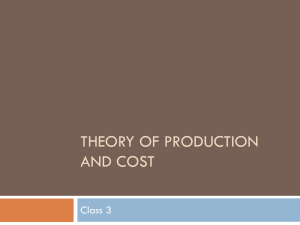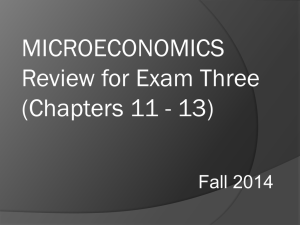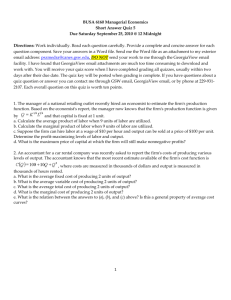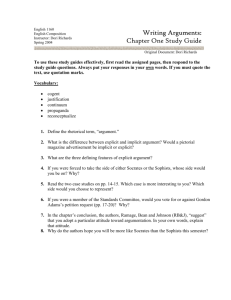Exam #3 Economics 2113 Principles of Microeconomics Dr. Philip
advertisement
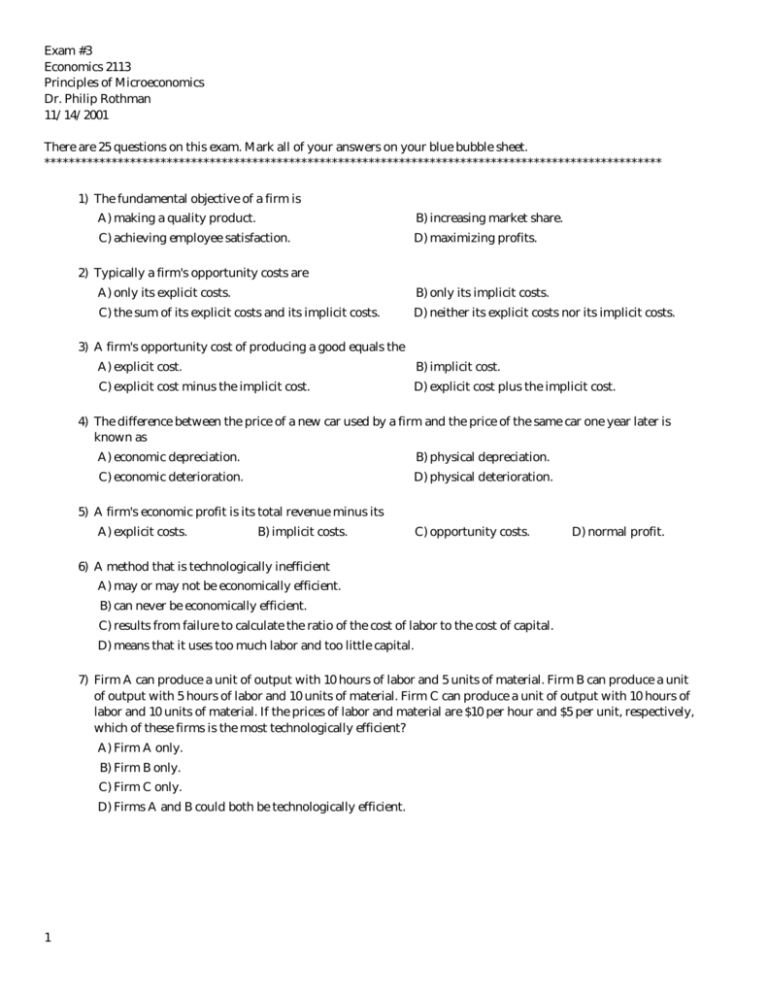
Exam #3 Economics 2113 Principles of Microeconomics Dr. Philip Rothman 11/14/2001 There are 25 questions on this exam. Mark all of your answers on your blue bubble sheet. ***************************************************************************************************** 1) The fundamental objective of a firm is A) making a quality product. B) increasing market share. C) achieving employee satisfaction. D) maximizing profits. 2) Typically a firm's opportunity costs are A) only its explicit costs. B) only its implicit costs. C) the sum of its explicit costs and its implicit costs. D) neither its explicit costs nor its implicit costs. 3) A firm's opportunity cost of producing a good equals the A) explicit cost. B) implicit cost. C) explicit cost minus the implicit cost. D) explicit cost plus the implicit cost. 4) The difference between the price of a new car used by a firm and the price of the same car one year later is known as A) economic depreciation. B) physical depreciation. C) economic deterioration. D) physical deterioration. 5) A firm's economic profit is its total revenue minus its A) explicit costs. B) implicit costs. C) opportunity costs. D) normal profit. 6) A method that is technologically inefficient A) may or may not be economically efficient. B) can never be economically efficient. C) results from failure to calculate the ratio of the cost of labor to the cost of capital. D) means that it uses too much labor and too little capital. 7) Firm A can produce a unit of output with 10 hours of labor and 5 units of material. Firm B can produce a unit of output with 5 hours of labor and 10 units of material. Firm C can produce a unit of output with 10 hours of labor and 10 units of material. If the prices of labor and material are $10 per hour and $5 per unit, respectively, which of these firms is the most technologically efficient? A) Firm A only. B) Firm B only. C) Firm C only. D) Firms A and B could both be technologically efficient. 1 8) The accountant for Muzhi's Sushi claims that Muzhi has accomplished "technological efficiency." This means that Muhzi's Sushi A) produces a given output using the least inputs. B) produces a given output at the lowest cost. C) has an economic profit greater than a normal profit. D) has a normal profit greater than a economic profit. 9) In the above table, the technique that is never economically efficient is A) A. B) B. C) C. D) D. 10) The principal-agent problem is the issue of inducing A) agents and principals to work hard. B) principals to act in the best interests of agents. C) agents to act in the best interests of principals. D) None of the above answers are correct. 11) A chief reason firms give employees bonuses based on the firm's profit is to cope with A) the tax laws. B) the law of diminishing returns. C) the principal-agent problem. D) unions. 12) Joe is a computer programmer who could work for a software company at $55,000 a year, but instead works for himself for $60,000. His only explicit costs are $1000 for blank CDs and $8000 for rent. Assuming Joe's normal profit is $2,000, his economic profit from working for himself is A) -$6,000. B) $6,000. C) $46,000. D) $48,000. E) -$5,000. 13) The short run is a period of time in which A) the quantity used of at least one input is fixed. B) the quantities used of all inputs are fixed. C) output prices are fixed. D) input prices are fixed. 14) The marginal product of labor is the change in total product caused by a one-unit increase in A) the quantity of labor employed, holding the quantity of capital constant. B) the quantity of capital employed, holding the quantity of labor constant. C) both the quantity of labor and the quantity of capital employed. D) the wage rate. 2 15) In the above table, the marginal product of the fourth worker is A) 1. B) 3. C) 4. D) 6. 16) Points on a firm's total product curve are A) both attainable and technologically efficient. B) neither attainable nor technologically efficient. C) attainable but not technologically efficient. D) technologically efficient but not attainable. 17) In the above figure, the average product of labor at point c is A) 10. B) 5. C) 2. D) None of the above answers are correct. 18) "Diminishing marginal returns" refer to a situation in which the A) marginal cost of the last worker hired is less than the marginal cost of the previous worker hired. B) average cost of the last worker hired is less than the average cost of the previous worker hired. C) marginal product of the last worker hired is less than the marginal product of the previous worker hired. D) average product of the last worker hired is less than the average product of the previous worker hired. 19) A firm has fixed costs 3 A) in the short run and in the long run. B) in the short run but not in the long run. C) in the long run but not in the short run. D) neither in the long run nor in the short run. 20) As output increases, marginal cost will A) eventually increase because of the law of increasing returns. B) eventually increase because of the law of diminishing returns. C) eventually decrease because of the law of diminishing returns. D) eventually decrease because of the law of increasing returns. 21) In a graph, if total fixed cost is measured along the vertical axis and total output along the horizontal axis, as output increases along the horizontal axis, the curve representing a firm's total fixed cost A) is horizontal. B) is vertical. C) has negative slope. D) has positive slope. 22) Using the data in the above table, the average fixed cost of producing 9 units per day is A) $2.22. B) $5.00. C) $5.55. D) $20.00. 23) A firm's average total cost is $100, its average variable cost is $90, and its total fixed cost is $1,000. Its output is A) less than 70 units. B) between 70 and 120 units. C) between 120 and 170 units. D) more than 170 units. 24) In the above figure, the average variable cost curve is curve A) A. 4 B) B. C) C. D) D. 25) The short-run average total cost curves for plants A, B, C and D are shown in the above figure. Which plant is best to use to produce 20 units per day? A) Plant A. 5 B) Plant B. C) Plant C. D) Plant D. Answer Key Testname: 2113_E3_F2001 1) Answer: D 2) Answer: C 3) Answer: D 4) Answer: A 5) Answer: C 6) Answer: B 7) Answer: D 8) Answer: A 9) Answer: C 10) Answer: C 11) Answer: C 12) Answer: A 13) Answer: A 14) Answer: A 15) Answer: B 16) Answer: A 17) Answer: B 18) Answer: C 19) Answer: B 20) Answer: B 21) Answer: A 22) Answer: A 23) Answer: B 24) Answer: C 25) Answer: A 1
